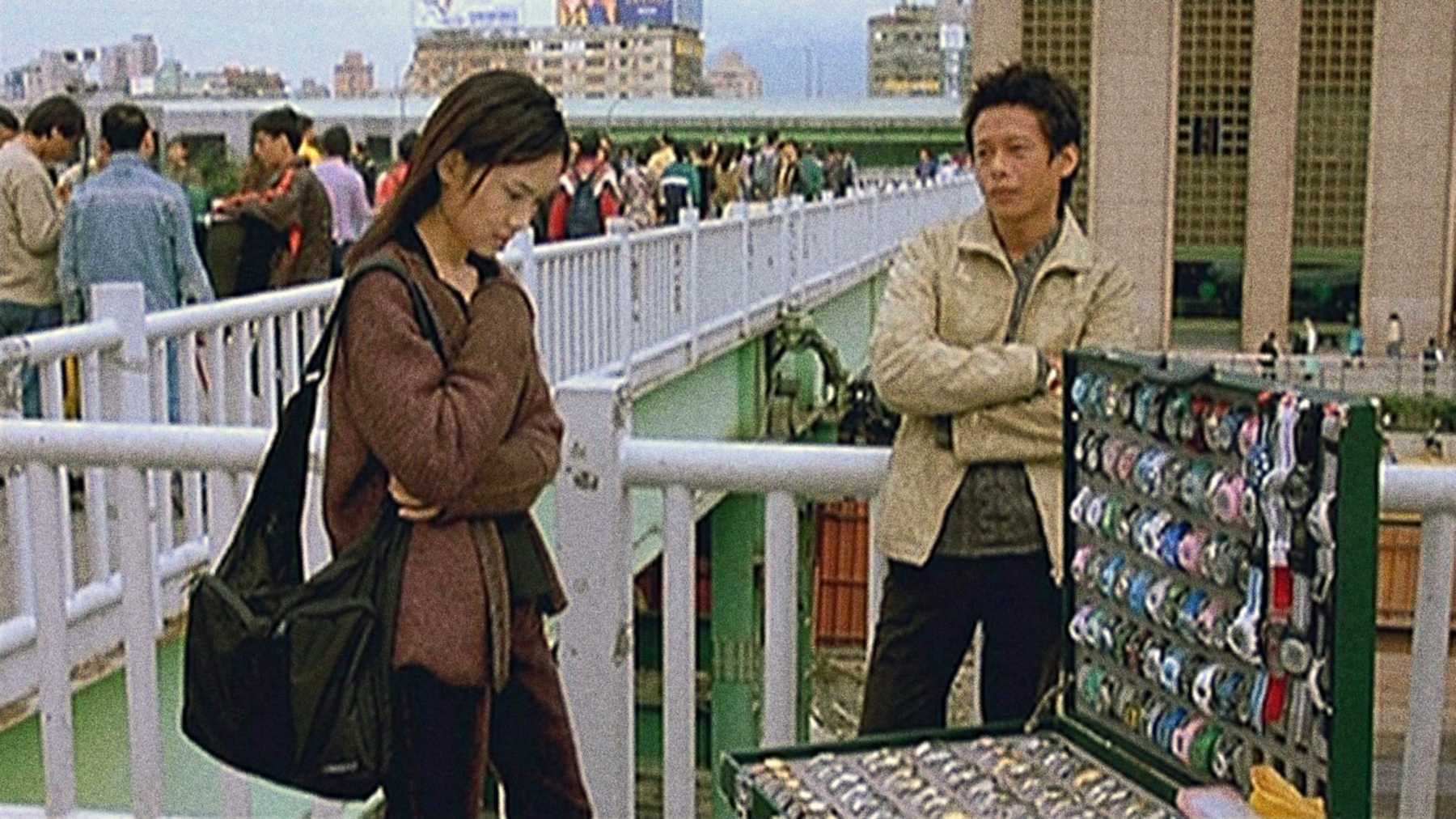By Chlotrudis Independent Film Society
Rating: 4 cats
Director: Ming-liang | Tsai
Starring: Kang-sheng Lee | Shiang-chyi Chen | Yi-ching Lu

Original language title: Ni neibian jidian
Country: taiwan
Year: 2002
Running time: 116
IMDB: http://us.imdb.com/Details?0269746
Michael says: “The story unfolds ever so slowly, and the pace doesn’t change throughout the nearly 2-hour running time, but is punctuated by sudden scenes of bizarre hilarity. WHAT TIME IS IT THERE? follows the lives of three people who struggle with grief and alienation. Hsiao-kang deals with the loss of his father very differently than his mother, and the two can’t see past themselves to understand what the other is going through. When Hsiao-kang, a street vendor who sells watches, reluctantly sells his own watch to Shiang-chyi, he becomes obsessed with her. Shiang-chyi needs a dual-time watch as she is leaving for Paris. Soon Hsiao-kang has set the time on his own watch for Paris time.
“While Hsiao-kang and his mother struggle with grief in Taipei, Shiang-chyi is having her own difficulties in Paris. Feeling increasingly isolated and alienated, she experiences a series of bizarre scenarios that leave her desperate to connect with anyone. The different ways these three character deal with their isolation is fascinating and beautiful.
“Director Ming-liang Tsai holds his scenes much longer than the viewer is used to, giving the film the feel of a painting. His muted lighting and lack of music bring a stark realism that Scot tells me is in the style of the French New Wave.
“This dark, portrait of urban loneliness and isolation is well worth a look.” 4 1/2 cats
And after a SECOND viewing: “Love this film. It’s truly an amazing piece of artwork. A tale of grief and alienation, WHAT TIME IS IT THERE looks at a mother and son, after their family patriarch passes away. While the mother struggles with her grief, the son becomes obsessed with a young woman who buys a dual-time watch from him before vacationing in Paris. While he busies himself changing all the clocks he finds to Paris time, the tourist struggles with the sense of displacement she encounters alone in Paris.
“Director Tsai Ming-liang sets up stunning albeit static shots that calls for the actors (and other miscellaneous on-screen appearances) to wander through the frame. Acting is great, with expressive facial expressions and body language.” 5 cats
Scot says: “I would argue that this is precisely the brilliance of the direction and cinematography. People move through their lives waiting for something to change, even moving between distinct locations within the frame as if that would help. It doesn’t.
“The static shots are so perfectly framed that Tsai is able to use depth of frame to define separate areas for parallel action or location shifts to occur. The heroine is frequently compared to Asian people in Paris (the guy waiting for the Metro, the woman outside the toilet stall) and contrasted with native Parisians (the fella in the crowded restaurant, the man at the general store). And in the first scene alone, the father is able to display his restlessness by moving into FOUR distinct locations, all within view of one long static shot. Beautiful!”
Bob says: “You guys beat me to it. You’ve said pretty much everything I was going to, but I would like to comment on my surprise at the general mood of the film. Based on the trailer, I was expecting a quirky little comedy. What I got instead was this beautiful, pensive look at sad, lost, lonely, slightly desperate people. The humor that is in there is really only intended to set off the general melancholy of the rest of the film — and of course, that’s really what the term ‘comic relief’ means: as in ‘relief map’, not ‘whew, what a relief.’
“It’s very brave of Tsai to trap his characters in those static spaces, allowing them only to move (occasionally) from one focal plane to another. It forces the actors to concentrate on the minutiae of their roles, it forces the viewers to experience the overall discomfort of the situation — even in a long shot taken outdoors (such as the clock tower scene) our gaze is very much stuck right where he wants it to be.
“All in all, I thought it was very personal, touching, and quite moving, particularly toward the end.”
Carolyn says: “Of Tsai’s films this has been my favorite. I think I like the romance and this did an interesting back and forth parallel between the guy in Taipei and the girl in Paris. The ending was somewhat indistinct but maybe there is a reason for that. 3.5 cats”
Laura says: “Tsai unfolds his film in a series of long, static, unedited shots. Once Tsai establishes his frame, his actors enter and exit it, even overshoot it. Tsai’s deliberate pace, though, may take some getting used to for American audiences. His film is slow to build and quick to drop off, but its mood permeates. Tsai’s screenplay (cowritten with Yang Pi-Ying) features very little dialogue, relying more on imagery (cinematography by Benoit Delhomme, THE SCENT OF GREEN PAPAYA; production design by Yip Kam Tim, CROUCHING TIGER, HIDDEN DRAGON) and his actors’ facial expressions and body language to propel his story.” 4 cats
For Laura’s complete review: “http://www.reelingreviews.com/whattimeisitthere.htm”
Robin says: “This is a quiet, thoughtful work that sprinkles satire and humor throughout as it takes a look at life’s simple moments. Hsiao-Kang keeps to himself, hawking his wares and tolerating his mother’s strange behavior as she prepares for the return of her dead husband’s spirit. She has taped over all the windows in their apartment so as not to have bright light disturb her ethereal spouse. Hsiao-Kang, during the night, must urinate into anything that doesn’t leak to avoid bumping into his dad’s ghost wandering the apartment. His chance meeting with the strong-willed Shiang-Chyi sets him off on his own obsession with Paris time.” 3 1/2 cats
For Robin’s complete review: “http://www.reelingreviews.com/whattimeisitthere.htm”
